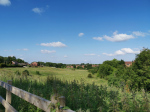The Lydgate Lads Buried Far From Home
Following Thursday’s article about the Clegg brothers who died during the Gallipoli Campaign (see here), today Saddleworth News tells the stories of two more Lydgate soldiers killed far away from Saddleworth during the First World War.
Both Samuel Hirst and Leonard Cox are among the 50 men remembered either on the village war memorial or in the churchyard of St Anne’s. Most are from Lydgate, Grasscroft or Springhead, or had some other connection to the church.
Local residents from the Love Lydgate group have been looking into their lives ahead of a special service on Armistice Day next month. The effort is being led by Andrew Heathcote, and his research has thrown up some fascinating tales.
While most of the 50 died in France or Belgium, Samuel Hirst is buried at Beersheba in modern-day Israel.
Born in Mossley to parents later recorded as living in Grasscroft, Samuel worked at the Royal George Mill in Greenfield before he joined the Royal Welsh Fusiliers, which fought in the Sinai and Palestine Campaigns.
Conflict had broken out in north Africa in 1915 when Ottoman Empire forces invaded Egypt, then a British protectorate. Samuel’s battalion, the 1st/7th of the Royal Welsh, saw action in Egypt and later on the advance into Palestine and on to Jerusalem.
Samuel was killed at the age of 22 on 6 November 1917, which suggests he perished during the Third Battle of Gaza. The week-long battle, which had begun with the fall of Beersheba, ended the following day in a British and Australian victory over the Ottomans.

Part of Samuel Hirst's division pictured in Bethlehem on 9 December 1917. (picture: public domain/Wikipedia)
Had he lived, Samuel would have gone with his division to Bethlehem which it occupied a month later on 9 December, the same day as Jerusalem surrendered to other British forces. Two days after that, the victorious British commander General Edmund Allenby made his famous entry into Jerusalem on foot, out of respect for its holy status.
But the British and the Ottomans weren’t just fighting for control of the Holy Land. Further east in Mesopotamia, modern day Iraq, there were years of battles too.
Among the British soldiers who took part was Leonard Cox, a millworker from Greenfield. He served as a Private in the 1st Battalion Manchester Regiment.
In March 1916, the regiment took part in the Battle of Dujaila, one of five failed attempts to relieve the besieged British garrison at Kut, a town 100 miles south-east of Baghdad.
When the British forces holed up there finally surrendered at the end of April, it proved to be one of the most humiliating moments of the war. Within months, a better supplied British force was back with a new commander in Frederick Maude, and the aim of avenging the defeat.
The new offensive began in December 1916 with an advance along the River Tigris, and it was a matter of weeks later that Leonard died, on 12 January 1917.
The St Anne’s parish magazine reported: “We deeply regret the necessity of having to record the death of another old member of St Mary’s – Leonard Cox, killed in action, and we offer our heart felt sympathy to his relatives. Two brothers out of three have now fallen, Fred being killed last year, and the third is at present serving in France.”
Leonard and Fred are one of seven pairs of brothers among the 50 remembered either on the memorial or in the churchyard at Lydgate. Leonard is buried at the Amara War Cemetery in what is now Iraq.
It seems likely that Leonard was killed during the Battle of Khadairi Bend, an offensive against Ottoman positions north of Kut set in a loop of the Tigris. Fighting took place during much of January, with the British finally winning the battle at the end of the month before advancing to Kut itself, which was recaptured on 24 February. Baghdad fell a fortnight later.
One soldier buried in Lydgate who lived to see the end of the war and a lot else besides is Thomas Steele from Springhead, who was awarded a Victoria Cross for his bravery during the same campaign.
He played a crucial role in repulsing an Ottoman counter-offensive near Kut on 22 February and, despite being seriously wounded, ended up living until 1978 when he died aged 87.
His ashes are interred at St Anne’s. There’s a lot more of his story to tell, but perhaps that’s one for another day! However, if you’d like to read his citation, you can do so here.
Background information from Wikipedia about the Sinai and Palestine Campaign is available here, and the Mesopotamian Campaign can be found here.
Andrew is keen to find out as much as possible about all of the fallen heroes, and asks that anyone who knows anything contact him by e-mail at this address: lydgate1914-18@hotmail.co.uk
A reminder that Thursday’s piece about the Clegg brothers and Gallipoli is available here. You can read more about the Love Lydgate group in a recent Saddleworth News article here.




